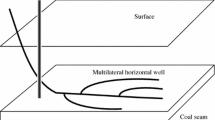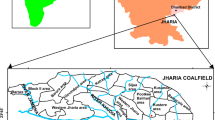Abstract
Sequestering carbon dioxide (CO2) with enhanced coalbed methane recovery (ECBM) is a promising clean coal technology in Indonesia, which can reduce CO2 emissions and potentially lower-cost alternative for fulfilling of future Indonesia’s gas demand. Coal seams in South Sumatera Basin, Indonesia, are well placed to take advantage of CO2 sequestration based on economical and regulatory criteria. From technical criteria assessment, there are very limited studies undertaken in this area, especially for identification of coal seams suitability for CO2-ECBM in South Sumatera Basin. This study has therefore aimed to propose the technical criteria of coal seams suitability for CO2-ECBM recovery as well as predicting CO2 storage capacity by developing a novel numerical model based on the characteristics of coal seams in South Sumatera Basin. The comparison of primary and CO2-ECBM recovery was analysed by performing production forecasting for 30 year of simulation. A sensitivity study was then conducted in order to examine the performance of CO2-ECBM under the influences of permeability, a determining factor in the viability of a CO2 storage in coal seams. A simplified method for estimating CO2 storage capacity in coal seams has been proposed which was validated with the novel numerical model through parametric studies. From this study, one can screen the suitable coal seams for CO2 storage with enhanced coalbed methane recovery and can quickly quantify the CO2 storage capacity in the coal seams with general available data.






Similar content being viewed by others
References
Bachu S, Bonijoly D, Bradshaw J, Burruss R, Holloway S, Christensen NP, Mathiassen OM (2007) CO2 storage capacity estimation: methodology and gaps. Int. J. Greenh. Gas Control 1:430–443
Bowe M, Moore TA (2015) Coalbed methane potential and current realisation in Indonesia. AAPG Article#90234
BP (British Petroleum) (2016) BP statistical review of world energy June 2016. BP, London
CBM Asia Development Corp (2013) Indonesia coalbed methane. CBM Asia Development Corp, British Columbia
Corum MD, Jones K, Warwic PD (2013) CO2 sequestration potential of unmineable coal—state of knowledge. Energy Procedia 37:5134–5140
Fujioka M, Furukawa H, Nako M (2008) The outcome of CO2-ECBM Yubari pilot test. J MMIJ 124:890–897
Giamminonni D, Fanello G, Kfoury M, Colombo I, Bonzani A (2010) Condensate banking phenomenon evaluation in heterogeneous low permeability reservoirs. In: SPE EUROPEC/EAGE annual conference and exhibition, 14–17 Jun 2010, Barcelona, Spain, Paper SPE 131582-MS
Gunter WD, Mavor MJ, Robinson JR (2004) CO2 storage and enhanced methane production: field testing at Fenn-Big Valley, Alberta, Canada, with application. GHGT-7 conference, Vancouver B.C., Sep 2004
Hasaneen R, Elsayed NA, Barrufet MA (2014) Analysis of the technical, microeconomic, and political impact of a carbon tax on carbon dioxide sequestration resulting from liquefied natural gas production. Clean Technol Environ Policy 16:1597–1613
Jasinge D, Ranjith PG (2011) Carbon dioxide sequestration in geologic formation with special reference to sequestration in deep coal seams. In: Proceedings of the 45th U.S. rock mechanics/geomechanics symposium
Kurnely K, Tamtomo B, Aprilian S, Doria I (2003) A preliminary study of development of coalbed methane (cbm) in South Sumatra. SPE Asia Pacific oil and gas conference and exhibition, 15–17 Apr 2003, Jakarta, Indonesia, Paper SPE 80518
LEMIGAS (Centre for Oil and Gas Technology) (2015) The latest status of carbon capture and storage (CCS) in Indonesia. R&D LEMIGAS, Ministry of Energy and Mineral Resources, Jakarta
Li X, Fang Z (2014) Current status and technical challenges of CO2 storage in coal seams and enhanced coalbed methane recovery: an overview. Int J Coal Sci Technol 1(1):93–102
Mazumder S, Sosrowidjojo B, Ficarra A (2010) The late miocene coalbed methane system in the South Sumatera basin of Indonesia. SPE Asia Pacific oil and gas conference, 18–20 Oct 2010, Brisbane, Queensland, Australia, Paper SPE 133488
Muksin N, Yusmen D, Waren R, Werdaya A, Djuhaeni (2012) Regional depositional environment model of Muara Enim formation and its significant implication for cbm prospectivity in South Sumatra basin, Indonesia. AAPG Article#80272
Pan ZJ (2012) CO2 ECBM field trial in China using a multi-lateral horizontal well. In: Presentation from the 6th Australia–China joint coordination group on clean coal technology and JCG low emission coal workshop, Hangzhou, 5–6 Dec 2012
Ridha S, Pratama E, Ismail MS (2017) Performance assessment of CO2 sequestration in a horizontal well for enhanced coalbed methane recovery in deep unmineable coal seams. Chem Eng Trans 56:589–594
Sosrowidjojo IB (2013) Coal geochemistry of the unconventional Muaraenim coalbed reservoir, South Sumatera basin: a case Study from the Rambutan field. Indones Min J 16(2):71–81
Stevens SH, Hadiyanto (2004) Indonesia: coalbed methane indicators and basin evaluation. In: SPE Asia Pacific oil and gas conference and exhibition, 18–20 Oct 2004, Perth, Australia, Paper SPE 88630
Thimons ED, Kissell FN (1973) Diffusion of methane through coal. Fuel 52(4):274–280
U.S. Department of Energy (2012) The 2012 United States carbon utilization and storage Atlas, 4th edn. National Energy Technology Laboratory, US
Wood Mackenzie (2017) South Sumatera basin CBM unconventional play. https://www.woodmac.com/ reports/unconventional-oil-and-gas-south-sumatra-basin-cbm-unconventional-play-16362891. Accessed 16 Jan 2017
World Bank (2015) The Indonesia carbon capture storage (CCS) capacity building program. http://documents.worldbank.org/curated/en/563781468284373788/pdf/FINAL-OK2-Jun-2415Cov-reduced-with-WB-cover.pdf. Accessed 23 Aug 2016
Yang DX, Zeng RS, Zhang Y, Wang ZQ, Wang S, Jin C (2012) Numerical simulation of multiphase flows of CO2 storage in saline aquifers in Daqingzijing oilfield, China. Clean Technol Environ Policy 14:609–618
Author information
Authors and Affiliations
Corresponding author
Rights and permissions
About this article
Cite this article
Pratama, E., Ismail, M.S. & Ridha, S. Identification of coal seams suitability for carbon dioxide sequestration with enhanced coalbed methane recovery: a case study in South Sumatera Basin, Indonesia. Clean Techn Environ Policy 20, 581–587 (2018). https://doi.org/10.1007/s10098-017-1383-4
Received:
Accepted:
Published:
Issue Date:
DOI: https://doi.org/10.1007/s10098-017-1383-4




